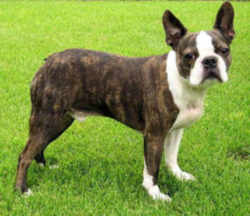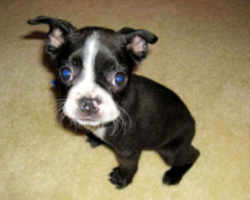
Massachusetts Symbols
Massachusetts State Dog
Boston Terrier

(C. l. familiaris)
Adopted in 1979
The Boston Terrier, (C. l. familiaris,) first purebred dog developed in America (1869); a cross between an English bulldog and an English terrier. The Boston Terrier was recognized by the Legislature in 1979 as Massachusetts State Dog. The legislation was introduced by Hon. Gregory W. Sullivan, 12th Norfolk District
The Boston has been nicknamed "the American Gentleman" because of his dapper appearance, characteristically gentle disposition and suitability as companion and house pet. They require only a moderate amount of exercise and a minimum amount of grooming. The breed is easy to train and they are easy keepers, preferring to remain by their owner's sides
Boston Terrier: Massachusetts State Dog

The Boston Terrier breed originated around 1870, when Robert C. Hooper of Boston purchased a dog named Hooper's Judge of a Bull and Terrier type lineage. Judge's specific lineage is unknown, however, Hooper's Judge is either directly related to the original Bull and Terrier breeds of the 1700s and early 1800s, or Judge is the result of modern English Bulldog's being crossed into terriers created in the 1860s for show purposes, like the White English Terrier.
Judge weighed over 29.7 pounds. Judge's offspring interbred with one or more French Bulldogs, providing the foundation for the Boston Terrier. Bred
down in size from pit-fighting dogs of the Bull and Terrier types, the Boston Terrier originally weighed up to 44 pounds. The breed was first shown
in Boston in 1870. By 1889 the breed had become popular in Boston that the dog fanciers formed the American Bull Terrier Club, however, this name was
not well received by the Bull Terrier Fanciers nor was the breed's nickname, "roundheads". Shortly thereafter, James Watson suggest that
the the club changed its name to the Boston Terrier Club, and in 1893 it was admitted to membership in the American Kennel Club, thus making it the
first US breed to be recognized. It is one of a small number of breeds to have originated in the United States. The Boston Terrier was the first non-sporting
dog bred in the US.
In the early years, the color and markings were not very important, but by the 1900s the breed's distinctive markings and color were written into the
standard, becoming an essential feature. Terrier only in name, the Boston Terrier has lost most of its ruthless desire for mayhem, preferring the company
of humans, although some males will still challenge other dogs if they feel their territory is being invaded.
Characteristic of Massachusetts Boston Terrier
Appearance
The Boston Terrier is a lively, highly intelligent, smooth coated, short-headed, compactly built, short-tailed, well balanced dog, brindle, seal or black in color and evenly marked with white. The head is in proportion to the size of the dog and the expression indicates a high degree of intelligence.
Size
Boston Terriers are typically small, compactly built, well proportioned dogs with erect ears, short tails, and a short muzzle that should be free of wrinkles.They usually have a square sort of face. According to international breed standard, the dog should weigh no less than 10 pounds and no more than 25 pounds. Few Boston Terriers weigh between 30 and 40 pounds, and most are considered healthy and not overweight due to their larger-than-average frame. Boston Terriers usually stand 15-17 inches at the withers
Coat and color
The body is rather short and well knit, the limbs strong and neatly turned, the tail is short and no feature is so prominent that the dog appears badly proportioned. The dog conveys an impression of determination, strength and activity, with style of a high order; carriage easy and graceful. A proportionate combination of "Color and White Markings" is a particularly distinctive feature of a representative specimen.
Temperament
Boston Terriers have friendly, very strong, lovable, unforgettable personalities. They can range in temperaments from those that are eager to please their master to those that are more stubborn. Both can be easily trained given a patient and assertive owner.
Health
Several health issues are of concern in the Boston Terrier: cataracts (both juvenile and adult type), cherry eye, luxating patellas, deafness, heart murmur, and allergies. Curvature of the back, called roaching, might be caused by patella problems with the rear legs, which in turn causes the dog to lean forward onto the forelegs
Massachusetts General Laws
The law designating the Boston terrier as the official Massachusetts state dog is found in the General Laws of Massachusetts, Part 1, Title 1, Chapter 2, Section 14.
PART I ADMINISTRATION OF THE GOVERNMENT
TITLE I JURISDICTION AND EMBLEMS OF THE COMMONWEALTH, THE GENERAL COURT, STATUTES AND PUBLIC DOCUMENTS
CHAPTER 2 ARMS, GREAT SEAL AND OTHER EMBLEMS OF THE COMMONWEALTH
Section 14 Dog or dog emblem of commonwealth
Section 14. The Boston terrier shall be the dog or dog emblem of the commonwealth.
Taxonomic Hierarchy: Boston Terrier
Kingdom: Animalia
Phylum: Chordata
Class: Mammalia
Order: Carnivora
Family: Canidae
Genus: Canis
Species: C. lupus
Subspecies: C. l. familiaris







